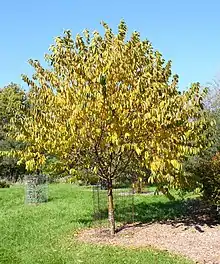Prunus maximowiczii
Prunus maximowiczii, known as Korean cherry,[3] Korean mountain cherry,[4] or Miyama cherry,[5] is a small (about 7.5 m), fruiting cherry tree that can be found growing wild in northeastern Asia and Eurasia.
| Prunus maximowiczii | |
|---|---|
 | |
| Prunus maximowiczii, Morton Arboretum, Lisle, Illinois | |
| Scientific classification | |
| Kingdom: | Plantae |
| Clade: | Tracheophytes |
| Clade: | Angiosperms |
| Clade: | Eudicots |
| Clade: | Rosids |
| Order: | Rosales |
| Family: | Rosaceae |
| Genus: | Prunus |
| Subgenus: | Prunus subg. Cerasus |
| Species: | P. maximowiczii |
| Binomial name | |
| Prunus maximowiczii | |
| Synonyms | |
Taxonomy
The species was first described in 1857 by Franz Josef Ruprecht. It was treated in the genus Cerasus (now generally accepted as a subgenus of Prunus) by Vladimir Leontyevich Komarov in 1927, but the original P. maximowiczii remains the widely accepted binomial.[1][2]
Description
P. maximowiczii has white, insect-pollinated, hermaphroditic flowers, blooming in May in the Northern Hemisphere, November in the Southern Hemisphere. The edible fruits (cherries) are about 5 mm in diameter, containing one large seed each. They ripen in August in the Northern Hemisphere, February in the Southern Hemisphere.[6]
Range and habitat
Korea, China (Heilong Jiang, Jilin, Liaoning, and Zhejiang), Russia (Khabarovsk, Primorye, and Sakhalin), and Japan (Hokkaido, Honshu, and Kyushu),[1] often in mountainous, woodland regions and in clayey soil.[7]
Uses
P. maximowiczii is useful in many ways; aside from eating the fruit, the flowers can be used as a condiment, preserved in brine.[6]
The wood of P. maximowiczii is very hard, heavy, and close grained, making it excellent for carving and the making of furniture.[6]
Dyes produced from the leaves of P. maximowiczii are green; and those from the fruit, a dark grey to green.[6]
Chemically, amygdalin and prunasin, the derivatives of which produce prussic acid[6] as well as Genistein[8] can be extracted from P. maximowiczii.
References
- Prunus maximowiczii was originally described and published in Bull. Cl. Phys.-Math. Acad. Imp. Sci. Saint-Petersbourg 15:131. 1857 ("1856"). "Prunus maximowiczii". Germplasm Resources Information Network (GRIN). Agricultural Research Service (ARS), United States Department of Agriculture (USDA). Retrieved May 28, 2010.
- Species was first published under the name Cerasus maximowiczii in V. L. Komarov & E. N. Klobukova-Alisova, Key pl. Far East. USSR 2:657. 1932. "Cerasus maximowiczii". Germplasm Resources Information Network (GRIN). Agricultural Research Service (ARS), United States Department of Agriculture (USDA). Retrieved May 28, 2010.
- USDA, NRCS (n.d.). "Prunus maximowiczii". The PLANTS Database (plants.usda.gov). Greensboro, North Carolina: National Plant Data Team. Retrieved 14 October 2015.
- English Names for Korean Native Plants (PDF). Pocheon: Korea National Arboretum. 2015. p. 591. ISBN 978-89-97450-98-5. Archived from the original (PDF) on 25 May 2017. Retrieved 22 December 2016 – via Korea Forest Service.
- Plants for a Future
- "Prunus maximowiczii". Retrieved May 28, 2010.
- "Prunus maximowiczii Miyama Cherry, Korean cherry PFAF Plant Database".
- "Chemical Information - GENISTEIN". Dr. Duke's Phytochemical and Ethnobotanical Databases. Retrieved May 28, 2010.
External links
- "Prunus maximowiczii". Plants for a Future.
- More images and information at Prunus maximowiczii at Cirrus Digital
